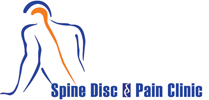DR. NEERAJ JAIN MD
SENIOR CONSULTANT INTERVENTIONAL PAIN SPECIALIST
SPINE & PAIN CLINIC, RU23 PITAMPURA, NEW DELHI. &
SRI BALAJI ACTION MEDICAL INSTITUTE
(M)9810033800 email-managepain@yahoo.com
Ozone Discectomy is the injection of Ozone inside the intervertebral disc in trouble. This is done as an outpatient under local anaesthesia with strict real time radiological control, which ensures the proper placement of Ozone in the center of the disc making it shrink.
LOW BACK PAIN, SCIATICA & PIVD:
Among working age people, as many as 20 percent experience back symptoms at least
every year. spinal diseases are the most common cause of disability in persons under the age of 45. Spine care results in expenditures two to three time greater than cardiac services for many health plans. While there is no specific data related to India, spine surgeons estimate that roughly 5% of the general population is affected by serious disc problems.
Some of the main causes of back pain include facet arthropathy, sciatica, muscle strain, sacroilitis, bulging or herniated discs and degenerative disc disease. Prolapsed intervertebral discs (PIVD) are the most common cause of low back pain associated with a defined structural Abnormality.
Patients who are not helped by weeks of conservative therapy are often referred for
surgery on the premise that further non-operative care is unlikely to help. Ideally, a patient with low back pain that has persisted beyond a four-week period should be referred to a multidisciplinary pain centre.
Different Non Surgical Interventions Employed Successfully:
Epidural Steroid Inj.
Epidurogram & Epidurolysis.
Nerve root sleeve/ transforaminal Inj.
Intra-discal steroid inj.
Nucleoplasty- Laser, Thermal & Mechanical
Ozone Discolysis
Conventional treatment methods for back pain comprise lamminectomy/ discectomy microsurgery, endoscopic disectomy and percutaneous arthoscopic disectomy, among others. These are invasive methods and their goal is to remove or contain the protruding disc. However, these methods have occasionally demonstrated a discrete incidence of failure and/or recurrence. Outcome studies of lumber disc surgeries documents, a success rate between 49% to 95% and re-operation after lumber disc surgeries ranging from 4% to 15%, have been noted. “In case of surgery, the chance of recurrence of pain is nearly 15 per cent as against less than three percent in Ozone treatment.
Reasons for the failures of conventional surgeries are:
1. Dural fibrosis
2. Arachnoidal adhesions
3. Muscels and fascial fibrosis
4. Mechanical instability resulting from the partial removal of boney & ligamentous structures required for surgical exposure & decompression
5. Presence of Neuropathy.
6. Multifactorial etiologies of back & leg pain , some left unaddressed surgically.
THE NEED FOR NEOTECHNOLOGY:
The various treatment options has confused clinicians and investigators due to high failure rate and complications associated with different kinds of surgeries and interventions. There has been surge of interest in search of safer alternative method of decompressing the nerve roots maintaining the structural stability.
Another safe least invasive alternative therapy that has been receiving exposure in Europe is the use of medical Ozone (02/03 mixture) in the treatment of PIVD. Epidural steroid injection, transforaminal epidural decompressions has a high success rate (up to 85%), but chances of recurrences are there specially if these interventions are done at later stage. Chemonucleolysis using chymopapain has also high success rate (80%) with low recurrences but not popular owing to the chances of anaphylaxis following intradiscal chymopapain injection. Injection of Ozone for discogenic radiculopathy (low back pain with radiation to legs) has developed as revolutionary alternative to chemonucleolysis and disc surgery .
THE OZONE REVOLUTION IN DISC DISEASES:
Muto suggested intradiscal injection of Ozone for disc hernia in 1998 under CT guidance. Leonardi popularized fluoroscopy guided Ozone injection into the intervertebral disc. After that successful outcome has been reported from various European centers. It is very important to note from those reports that complications are remarkably few. Not a serious single life threatening complication was found even after 120,000 cases of Ozone nucleolysis, which stresses the safety of these procedures.
The most critical portion of performing any of the minimally invasive procedures is accurate and safe positioning of the needle (or terminal device) in the centre of the disc space. The risk in ozonucleolysis is particularly minimised, with the use of a very thin 22/25-gauge needle. It may take anywhere from 5 to 30 minutes to position a needle in the centre of the disc space under radiological guidance. Once the needle is safely placed in position, ozonucleolysis is completed in only another 2 to 3 minutes.
HOW DOES OZONE WORK ?
There are four main biochemical actions on the intervertebral disc and its surrounding tissues. The various proposed mechanisms of action are:
BY “MUMMIFICATION” OF THE DISC.
Intra/intermolecular Bonds and collapse of the threedimensional Structure of the disc.
The plausible mechanism of action is the direct effect of the ozone on the Herniation. It is well established that the nucleus pulposus (the actual part of the disc that herniates through annulus) is 70-90% water contained within the domain of proteoglycans. The water binding capacity of the proteoglycan molecule is partially a property of its size and physical shape, but the main force that holds water to the molecule stems from the ionic, carboxyl (COOH) and sulphate (SO4) radicals of the glycosaminoglycan chains. The ozone can have a direct effect on these carboxyl and sulphate groups, breaking down some of these glycosaminoglycan chains which make up the proteoglycans. The destruction of these cross-linked structures reduces their ability to hold water therefore diminishing the size of the herniation by dehydration of the fibrillary matrix of the nucleus pulposus, revealing collagen fibers and signs of regression (vacuole formation and fragmentation)- a sort of disk “mummification.”
BY INHIBITING INFLAMMATORY NOCICEPTORS.
Synthesis of Prostaglandines & Secretion of Proteinases
Liberation of Bradykinines and Pain Inducing Products
Several studies suggest disc inflammation as a mechanism of sciatica due to disc herniation. Ozone has been shown to have an effect on the inflammatory cascade by inhibiting synthesis of proinflammatory prostaglandins or release of bradykinin or release of algogenic compounds; increased release of antagonists or soluble receptors able to neutralize proinflammatory cytokines like interleukin (IL)-1, IL-2, IL-8, IL-12, IL-15, interferon, and tumor necrosis factor. Therefore, by reducing the inflammatory components there is a corresponding reduction in pain.
BY STIMULATING FIBROBLASTS & IMMUNOSUPPRESSOR CYTOKINES
Local production of Antioxidant Enzymes
Release of immunosuppressor cytokines like transforming growth factor, and IL-10
Another action which may prove to be one of the most important is the stimulation of
fibroblastic activity by ozone. Fibroblasts initiate the repair process by stimulating the
deposition of collagen. Although yet to be validated, this mode of action could
explain the resolution of PIVD on CT scans and the small percentage of patients who
have relapses after the completion of treatment plan.
“Ozone may have a reflex therapy effect called ‘chemical acupuncture’, breaking the chain of chronic pain stimulating anti-nociceptor analgesic mechanism. As pain is multi-factorial, ozone may also have a multi-factorial pharmacological effect alleviating disc compression by shrinkage of the herniated disc.”
BY IMPROVING MICROCIRCULATION & OXYGENATION.
The direct effect is the oxygen directly diffusing into the area.
The indirect action is the Ozone causing an increase in 2,3-DPG (diphosphoglycerate) which has a direct effect in the release of O2 from hemoglobin.. The end result is an increase in the amount of oxygen and a reduction in anoxia.
Disk shrinkage may also help to reduce venous stasis caused by disk compression of
vessels, thereby improving local microcirculation and increasing the supply of oxygen.
This effect has a positive effect on pain as the nerve roots are sensitive to hypoxia.
RESULTS & SAFETY:
In a multi-centre, retrospective 3 year follow-up study of lumber disc herniation treated with European Neurosurgical Institute protocol of ozone therapy in 917 patients showed 78.9% good & excellent results with only one case of disc infection which healed with antibiotic.
In fact, over 120,000 patients have been treated successfully worldwide using injection of medical ozone with a success rate of 80-90% and with a near nil rate of procedure-related complications. “The procedure is a safe and effective alternative to open surgical procedure. Patients get the advantage of going home after a short recovery on the same day. They generally go to work within a week and are spared prolonged absence from work and disability,” The treatment relieves pain substantially and, after two sittings, people “can go back to work under medical guidance”.
COMPARISON: SPINAL SURGERY OZONE DISCOLYSIS
1. More Hospital Stay. One day/Day Care.
2 Complications of prolonged surgery& anaesthesia GA is not required
3 “failed back surgery syndrome” No “failed back surgery syndrome”
4 High Cost Total cost is 1/5th to 1/10th
5 Failure rate 10-51% Comparable 10-21%
6 Safety profile comparatively not so high. Very high safety profile
7 Repeat surgeries are more complicated. May be safely repeated many times
8 Cervical PIVD poses a surgical challenge Ideal procedure in cervical PIVD
9 Highly invasive very demanding surgery Least invasive much easier procedure
10 High postoperative morbidity Negligible morbidity
11 In-patient major surgery Mostly OPD procedure
CONCLUSION:
Ozone Discectomy a revolutionary least invasive safe & effective alternative to spine surgery is the treatment of choice for prolapsed disc (PIVD) done under local anaesthesia in a day care setting. This procedure is ideally suited for cervical & lumbar disc herniation with radiculopathy. Total cost of the procedure is much less than that of surgical discectomy. All these facts have made this procedure very popular at European countries. It is also gaining popularity in our country due to high success rate, less invasiveness, fewer chances of recurrences, remarkably fewer side effects meaning high safety profile, short hospital stay, no post operative discomfort or morbidity and low cost.








No Comments
This post is password protected. Enter the password to view any comments.